Welcome to a new issue of the Journal of Runic Studies, the premier Malkioni publication for studies into the nature of Glorantha. If you haven’t subscribed yet, please consult with the spirit bound to the appropriate electronic page.
Chaosium News
The Red Book of Magic
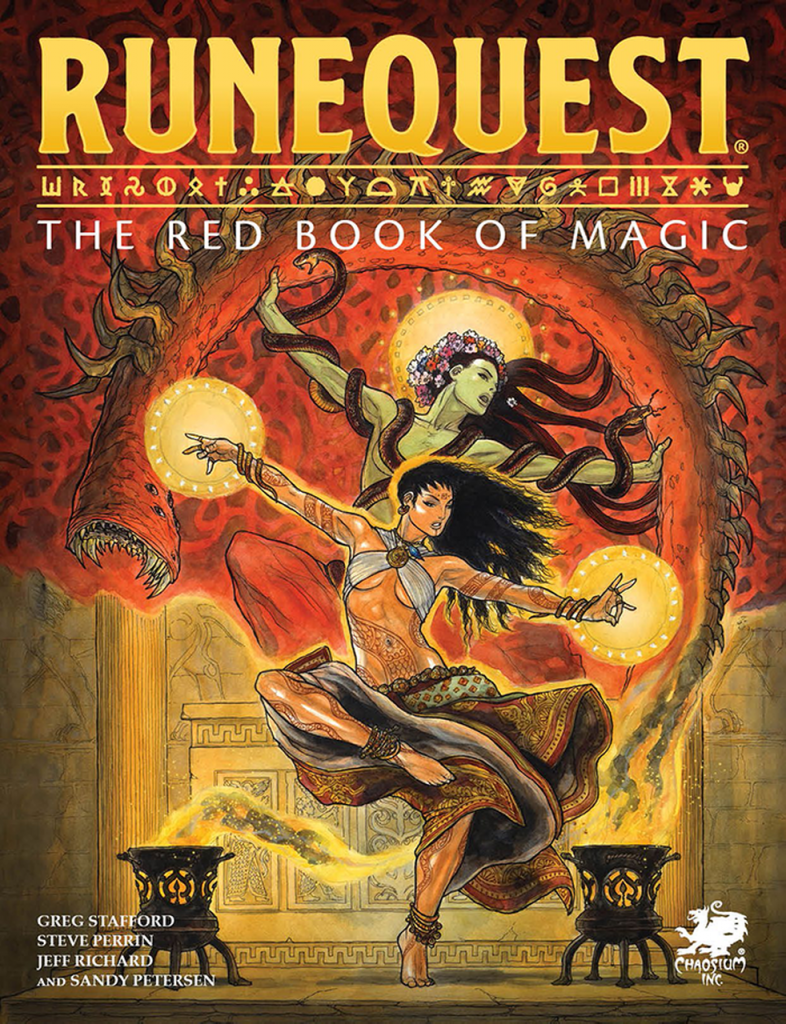
The Red Book of Magic has been released in hardcover and leatherette versions! As always, if you previously bought the PDF from Chaosium, you should have received a coupon to get the corresponding discount from the physical product. And if you were waiting for several books to come out to make a bulk order, don’t forget to contact Dustin and request a combined coupon code.
By the way, do you like this cover by Mark Smylie? Then get it on a t-shirt, on a mug, on a pillow, on a notebook, and even, what the heck, on shower curtains! There’s a lot more stuff available at Chaosium’s Redbubble store.
Jeff’s Bits
Jeff keeps sharing many interesting things on the RuneQuest facebook group. Here are the highlights from this week!
The Lunar and Roman Empires
Even though comparisons between the Lunar and Roman Empires are easy to make (if only for the resemblance of lingo and names between the two), there is still one big difference: the Lunar Empire is tiny by comparison.
[…] both in terms of territory and population. The Lunar Empire includes about 8.5 million humans, with another million non-humans (elves, dwarfs, trolls, etc.) in its orbit.
By most accounts, the Roman Empire at its height numbered around 40-50 million people and Han China somewhere around 50 million. Likely the Assyrians or Neo-Babylonians or some of the Successors are better points of comparison in terms of population and territory. Rome or Han China – that’s like the Middle Sea Empire at its peak.
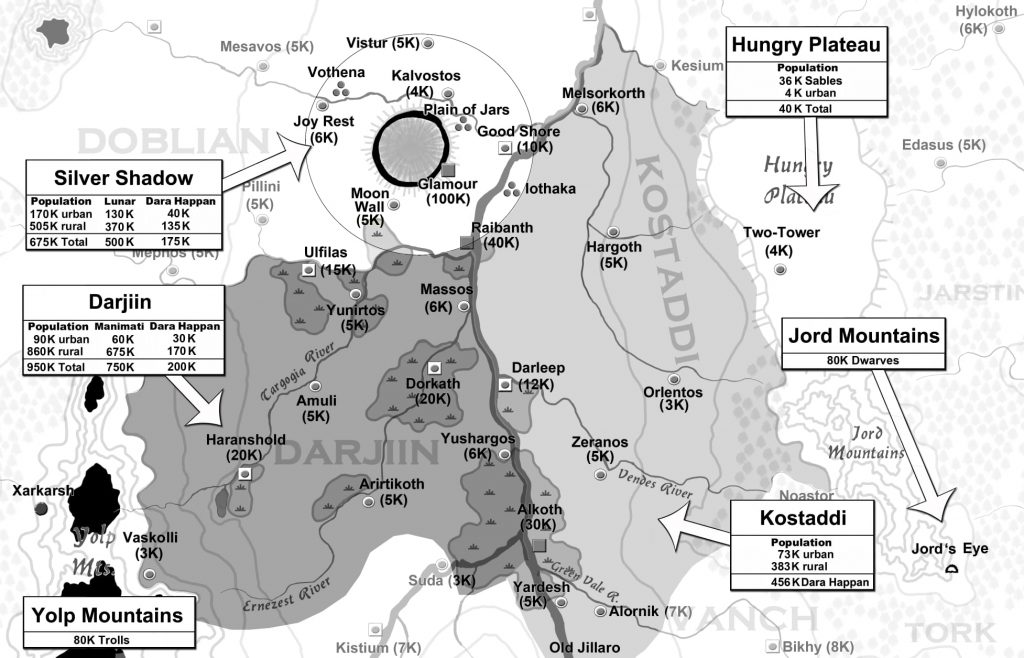
Nick Brooke, resident Lunar expert, adds:
In case there was any doubt, when we say that the Roman Empire is a useful model for the Lunar Empire, we don’t mean that the Lunar Empire’s capital is Rome and that it extends from the Sahara to Germania, and from Britannia to the Parthian desert, with a similar population (size, density, ethnic composition, religious affiliation, etc.).
We mean that Lunars in your games can look and act just like the Romans you’ve seen in “Gladiator,” “Rome,” “I Claudius,” “Life of Brian” and “Carry on Cleo” (among other impeccable sword & sandal sources), with appropriate localisation (Moons and Bats, not SPQRs and Eagles), if that works for you. That’s what analogies and models are for.
Brithini Cosmology
Some Brithini cosmology text explains the creation of the world:
The invisible God is all things. He is beyond knowing or feeling or being. He contains all things and will contain them all in the future. He is beyond life or entropy.Within the Invisible God is Existence, and within Existence were conceived the Laws. All things outside the Laws were excluded and cast down, and those things were of chaos and entropy.
This is an interesting one because it reframes most of the monomyth’s big events with the Invisible God and the concepts of Wisdom and Ignorance, and Malkion and Zzabur as the main protagonists.
Jeff’s comments provide a lot more insight, especially about Brithini philosophy and how they view mortals. These wizards are at minimum 12 centuries old and have seen many generations of “simulacra” (humans and other mortals) go by. The Brithini are not emotionless, as they have developed a deep understanding of emotions and life experiences, but most will have long lost interest in mortals and their affairs.
Malkionism and Hrestolism
Still on the topic of the humanists of Glorantha, Jeff posted a quick recap of Malkionism.
Although all speak of an “Invisible God” as the ultimate reality, they are differ in their views and practices. Some view the lesser divine entities as emanations of the Invisible God, others view them as mere anthropomorphic embodiments of natural forces, and still others view them as self-deluded siblings of Zzabur who conflate themselves with the energies they have mastered.
The interesting bits for me however were in the comments:
So it should be clear that for me the Malkioni are a vehicle for exploring logic and philosophy. They include Plato, Aristotle, Heraclitus, and Zeno, as well as the Upanishads, the Brahma Sutras and Gaudapada.
And:
Also when thinking about Malkionism, remember that it changes over time. Before the Dawn, the Brithini dealt with the gods as near equals and the Seshnegi worshiped Malkion and Seshna Likita the Earth Goddess. In the Third Age, the main Malkioni schools no longer interact with the gods as equals, but also do not worship gods other than Malkion and his family, and a few important heroes.
And:
This divergence between Brithinism and Hrestolism occured over 1600 years ago, and Malkionism has developed radically differently from their Brithini origins.
It sounds to me like having your players run into some Western philosophers would be a good way for them to question why their Lhankor Mhy cultist is called a “philosopher” too when what they do is really just boost the fighters’ weapon damage and detect traps when going into dungeons… 😋
The Holy Country
It looks like the upcoming Cults book will have a whole lot of general lore material, if we go by yet another preview from the book regarding the Holy Country:
The accession of the God-King in 1318 also marks the beginning of the term Holy Country to describe Kethaela, and it soon gained a reputation for being a place of mystery and wonder.
[…]
The God-King kept good contacts with all the gods of the Holy Country, and to the rest of the world this was a part of the Otherworld manifest in the mundane world. Occasionally, gods or great monsters visited the Holy Country, and there were known to be many secret gates into the Otherworld.
The God-King showed little interest in expanding his realm. He used friends and allies to guard his borders, sent messengers and merchants outward, to the west, through Maniria to Ralios.
This last paragraph is important, especially when you consider that the Holy Country has often been summed up as “Mythological Disneyland ruled by a God King fueled by Battle Royale” (which, incidentally, is one of those descriptions that never fails to grab someone’s attention). Unlike the aforementioned real-world’s Empire of Entertainment, and unlike the other ever-reincarnating ruler that we love so much, it sounds like Belintar wasn’t interested in expansion and acquisitions, which I guess puts him out of the highly contested “top horrible Gloranthan figures” list.
And what about the City of Wonders? Well, it looks like this was the equivalent of Main Street, U.S.A, where you can take selfies with Mickey Mouse, Darth Vader, and any of the Disney Princesses before going for a smoothie at a nearby stand:
Gods and spirits dwelled in the City of Wonders alongside mortals and powerful magical entities like the Reef Master or the Tide Lord. So you might go to the Golden Anchor for a drink and meet a visiting Triton or a son of the Storm Bull who has come here from Stormwalk Mountain.
Look at this wonderful early map from Greg for the Holy Country:
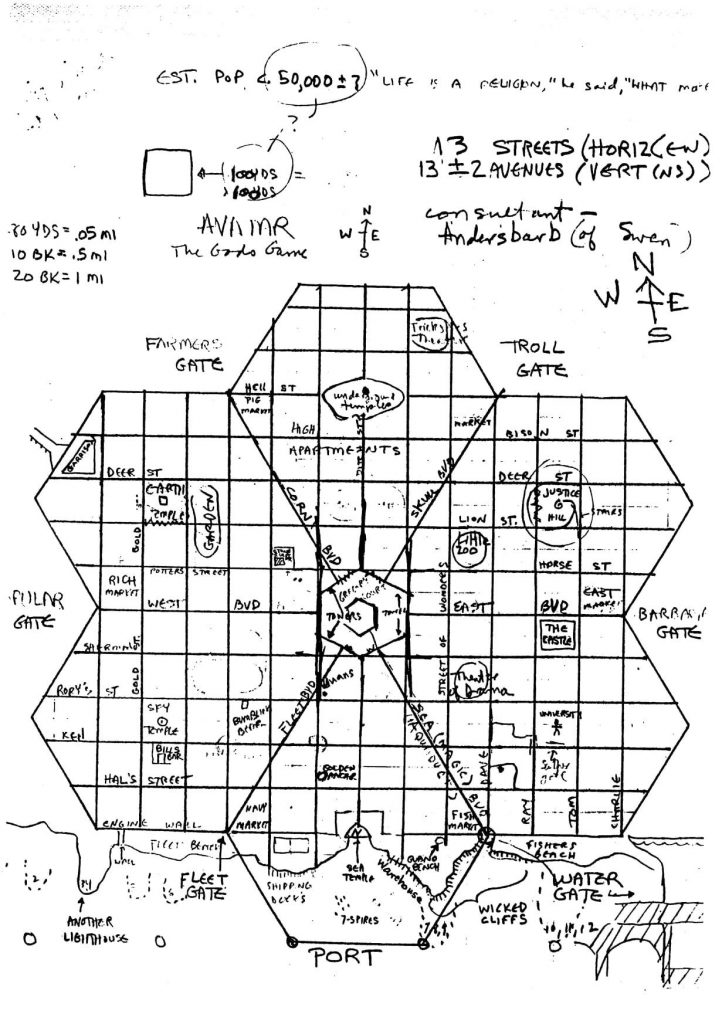
Let’s visit Darkworld early to beat the crowd, we can always go to Earthlands after lunch, the rides mostly suck there anyway.
Heroquesting
A little glimpse into how heroquesting works in general:
A heroquest is a direct interaction with the divine realm of myth and archetypes. In a heroquest, you interact and experience the divine realm and bring back magic, be it Rune spells, guardian spirits, good harvest, a terrible curse, something long forgotten and hidden, etc.
As we interact with the kaleidoscopic divine realm, we of course change its arrangement. Like walking into a room of swirling smoke, our presence causes the mist to swirl around us, changing its direction and patterns. Most of the time we have little control of the changes – we enter the room, the smoke swirls because of our mere presence.
And a history of heroquesting, from the Dawn to the Hero Wars:
Arkat Chaosbane was the first individual to discover heroquesting outside of a specific cult myth. He underwent several secret initiations (and excommunications) which gave him an unusual transcultural view of the secret world of myth. His personal experiences gave him clues which he followed, exploited, and taught to others.
The Monomyth is your Friend
Yes. Trust us. We’re the God Learners after all.
To those Gloranthans who do know of the monomyth it is a convenient philosophical overview, an attempt to translate peculiarities into universalities, to overcome the limitations and boundaries of language and parochial existence, or another deception by Gbaji to lead the world to ruin. But it cannot be forgotten that most of the inhabitants of Glorantha do not care about the mythic structure beyond their own belief structure.
In fact, we are all God Learners:
Even if the God Learners are now gone and cursed, the Mythical Synthesis Movement has already done its work. In a sense, we are all God Learners now.
This might get embarrassing if you keep criticizing the God Learners:
“And what of those fancy tattoos which you value so highly – did you know they were a God Learner affectation too?”
“She Cheated”
Here’s an Orlanthi tale about the rise of the Red Goddess. This shoudn’t be surprising:
She won because she cheated. She won because she did not obey the normal laws of war and of creation. Things which simply could not be, were! This was where she had one son, in many bodies! Where she had a body part, as a living being! Where she had her shadow self, better than her!
And speaking of Orlanthi points of view, Argrath’s scribes have the best nicknames for Jar-Eel:
Of all the many crimes committed by the the Poisonblood Witch-Queen of the Lunar Empire, perhaps the greatest crime was when she assassinated Belintar the God-King and ended the divine proximity of the Holy Country. A crime boasted of by the Lunars, serving no purpose except to facilitate their imperial conquests.
I don’t know about you but “Poisonblood Witch-Queen” kinda makes me want to take her side… too bad she helped destroy Disneyland, though, that was definitely not cool.
Formative Female Experiences
In an interesting break of form, Jeff asked for ideas from the community on what would be the female gender role equivalent to the formative experience of the cattle raid.
This is always a tricky thing with Gloranthan lore and gaming: it tries to emulate the gendered roles of real-world mythology and ancient cultures, but this often leaves female gender roles as very passive. Staying home to be pregnant isn’t a very exciting prospect for female characters, in addition to the patriarchal worldbuilding issues it brings with it. Some comments offer interesting ideas, but I think this is an issue that Glorantha game writers will keep struggling with for a long time. I wonder if it would have been easier in the end to prioritize gameplay rather than spiritual verisimilitude during Glorantha’s early years?
Jonstown Compendium
Print-on-Demand Sale!
DriveThruRPG is running a site-wide sale for all premium-color POD books which will see changes (like price increases) on July 1st. Now’s your last chance to grab these books at a reasonable price!
Of course, the Jonstown Compendium titles are participating in it, so buy them while you can, especially titles like Valley of Plenty which are actually going to become PDF-only in a couple days! In fact, the Jonstown Compendium books are completely smashing DriveThruRPG’s “hottest community books” category, as you can see below:

Most of the non-Gloranthan books in this top-16 sample are from the Miskatonic Repository, which is the community content program for Call of Cthulhu. Way to go, Chaosium fans!
Other books might interest the RuneQuest Glorantha crowd too, such as the recently released (and well received!) Mythic Babylon for Mythras.
Miniatures
Fenris Games has some duck adventurers coming back in stock soon. Keep an eye out for those:
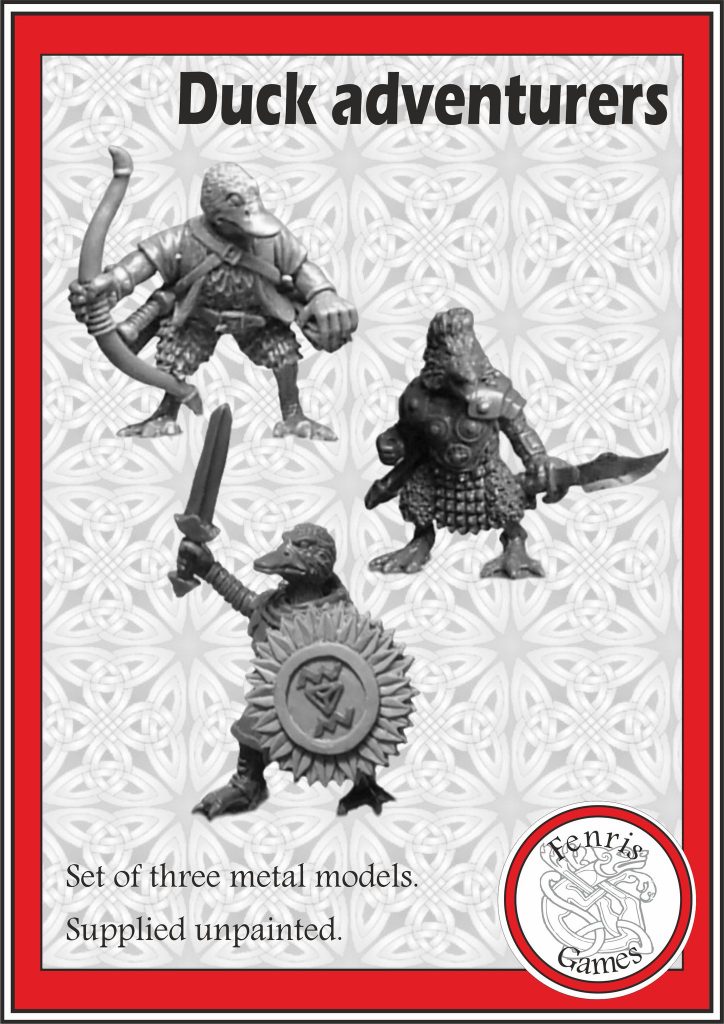
They are also teasing some new models coming to Kickstarter later this year! Of course, we’ll report back here when that happens.
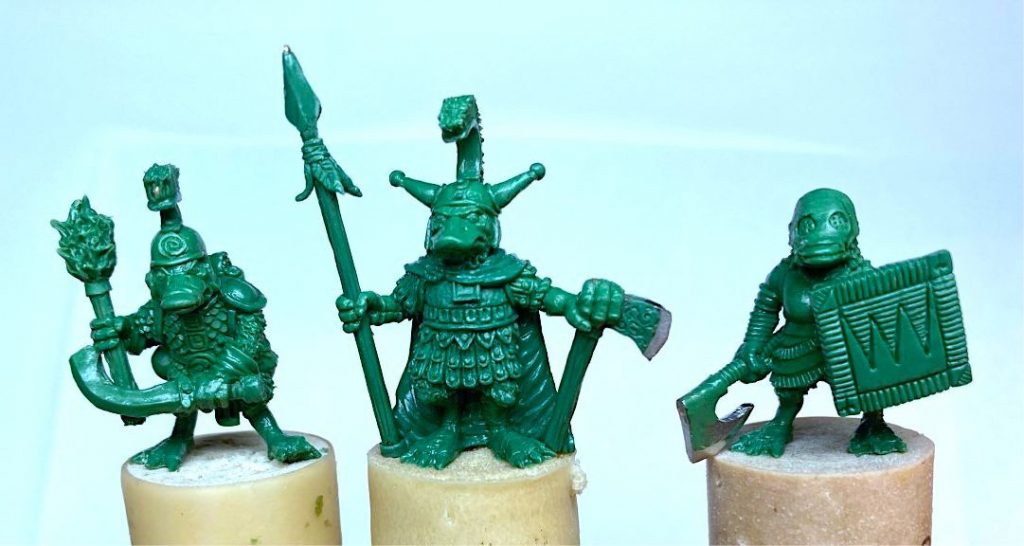
Arnesonian Classes
The OSR darling Old School Essentials has a new sourcebook called The Lost Classes: Arnesonian Classes, which brings back classes from the experimental early years of D&D… in this case, directly from Dave Arneson’s campaigns.

One of the two classes in this short sourcebook is an undead-slayer Duck… sounds familiar?
Reviews
The GROGNARDIA blog reviewed Cults of Terror, the classic RQ2 sourcebook full of cults and magic for baddies.
Each of the cults in this book get very detailed write-ups, providing plenty of insight not just into the beliefs and activities, but also their place within the setting of Glorantha. It’s in this area where Cults of Terror excels. In some ways, it’s even superior to Cults of Prax, because much more is revealed about the myths, history, and cosmology of Glorantha.

They had covered Cults of Prax previously, along with many other old school games and supplements.
I had also missed this recent review of RQ2 by well-known and well-named Gloranthan blogger Runeblogger.

I also found it surprising that the purpose of RuneQuest is clearly laid out here: Adventurers gain experience, magic, and treasure by overcoming the scenarios the GM creates for them. Then they use that treasure to purchase training to further develop their skills until they are so proficient they meet the requirements to join a rune cult. Acquiring rune magic seems to be, then, the quest referred to in the name of the game.
Well, I guess the newest version of RuneQuest then starts us off with that quest fulfilled! Not much else to do with these new characters besides murdering and looting, eh? 😇
Thank you for reading
That’s it for this week! Please contact us with any feedback, question, or news item we’ve missed!

